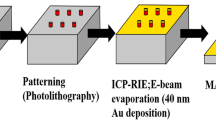Abstract
Low-cost fabrication methods enabling the morphological control of silicon nanowires are of great importance in many device application fields. A top-down fabrication method, metal-assisted chemical etching, is proved to be a feasible solution. In this paper, some novel approaches based on metal-assisted chemical etching, alkaline solution etching, and electrochemical anodic etching are presented for fabricating micro- and nano-structures, which reveal the anisotropic characteristics of metal-assisted chemical etching in silicon. A new model is proposed to explain the motility behavior of Ag particles in metal-assisted chemical etching of silicon. It is shown that Ag particle forms a self-electrophoresis unit and migrates into Si substrate along [100] direction independently. Diameter and length control of silicon nanowires are achieved by varying Ag deposition and etching durations of metal-assisted chemical etching, respectively, which provide a facilitation to achieve high-aspect-ratio silicon nanowires at room temperature in a short period. These results show a potential simple method to microstructure silicon for devices application, such as solar cells and sensors.











Similar content being viewed by others
References
Zubel I (1998) Sens Actuator A Phys 70:260
Schuster R, Kirchner V, Allongue P, Ertl G (2000) Science 289:98
Chadwick EG, Clarkin OM, Tanner DA (2010) J Mater Sci 45:6562. doi:10.1007/s10853-010-4745-4
Chadwick EG, Beloshapkin S, Tanner DA (2012) J Mater Sci 47:2396. doi:10.1007/s10853-011-6060-0
Baker-Finch SC, McIntosh KR (2012) Prog Photovolt 20:51. doi:10.1002/pip.1109
TK Chong, J Wilson, S Mokkapati, KR Catchpole (2012) J Opt 14. doi:10.1088/2040-8978/14/2/024012
Wu Y, Zhang G, Xi Z (2011) Mater Sci Semicond Process 14:302. doi:10.1016/j.mssp.2011.02.008
Yan L, Minghui H (2012) J Mater Sci 47:1594. doi:10.1007/s10853-011-6157-5
Li SQ, Wijesinghe T, Blackwood DJ (2008) Adv Mater 20:3165. doi:10.1002/adma.200800090
LL Ma, YC Zhou, N Jiang, et al. (2006) Appl Phys Lett 88. doi:10.1063/1.2199593
Qu Y, Liao L, Li Y, Zhang H, Huang Y, Duan X (2009) Nano Lett 9:4539. doi:10.1021/nl903030h
Garnett EC, Liang WJ, Yang PD (2007) Adv Mater 19:2946. doi:10.1002/adma.200700288
Lv M, Su S, He Y et al (2010) Adv Mater 22:5463. doi:10.1002/adma.201001934
Chen CY, Wu CS, Chou CJ, Yen TJ (2008) Adv Mater 20:3811. doi:10.1002/adma.200702788
Huang ZP, Fang H, Zhu J (2007) Adv Mater 19:744. doi:10.1002/adma.200600892
Schmidt V, Wittemann JV, Senz S, Gosele U (2009) Adv Mater 21:2681. doi:10.1002/adma.200803754
Huang ZP, Geyer N, Werner P, de Boor J, Gosele U (2011) Adv Mater 23:285. doi:10.1002/adma.201001784
B Ozdemir, M Kulakci, R Turan, HE Unalan (2011) Nanotechnology 22. doi:10.1088/0957-4484/22/15/155606
Peng K, Yan Y, Gao S, Zhu J (2003) Adv Funct Mater 13:127. doi:10.1002/adfm.200390018
Tsujino K, Matsumura M (2005) Adv Mater 17:1045. doi:10.1002/adma.200401681
Fang H, Wu Y, Zhao JH, Zhu J (2006) Nanotechnology 17:3768. doi:10.1088/0957-4484/17/15/026
Hui F, Xudong L, Shuang S, Ying X, Jing Z (2008) Nanotechnology 19:255703
Peng K, Xu Y, Wu Y, Yan Y, Lee S-T, Zhu J (2005) Small 1:1062. doi:10.1002/smll.200500137
Peng K, Wu Y, Fang H, Zhong X, Xu Y, Zhu J (2005) Angew Chem Int Ed 44:2737. doi:10.1002/anie.200462995
Zhao Y, Li DS, Sang WB, Yang D, Jiang MH (2007) J Mater Sci 42:8496. doi:10.1007/s10853-007-1749-9
Kovacs GTA, Maluf NI, Petersen KE (1998) Proc IEEE 86:1536
Weiss D, Gebensleben T, Diestel L, Alphei L, Becker V, Becker JA (2011) J Mater Sci 46:3436. doi:10.1007/s10853-010-5246-1
Peng K, Lu A, Zhang R, Lee S-T (2008) Adv Funct Mater 18:3026. doi:10.1002/adfm.200800371
Celler GK, Barr DL, Rosamilia JM (2000) Electrochem Solid State Lett 3:47
Zubel I, Barycka I (1998) Sens Actuator A Phys 70:250
Foll H, Christophersen M, Carstensen J, Hasse G (2002) Mater Sci Eng R Rep 39:93
Zubel I (2000) Sens Actuator A Phys 84:116
Acknowledgements
This work was mostly supported by the National Basic Research Program of China (Grant No. 2012CB934200), and National Natural Science Foundation of China (Contract Nos. 50990064, 61076009, 61204002).
Author information
Authors and Affiliations
Corresponding author
Rights and permissions
About this article
Cite this article
Liu, K., Qu, S., Zhang, X. et al. Anisotropic characteristics and morphological control of silicon nanowires fabricated by metal-assisted chemical etching. J Mater Sci 48, 1755–1762 (2013). https://doi.org/10.1007/s10853-012-6936-7
Received:
Accepted:
Published:
Issue Date:
DOI: https://doi.org/10.1007/s10853-012-6936-7




